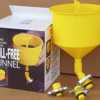First off, I was a bit surprised to see Doug asking for our wisdom. He always seems to do pretty good all by himself; his advice is always accurate and well thought out.
As for our two coolant system tanks.
I"d really like for us to all agree on proper terms for the two tanks. It is often hard for me, an owner for 12 years, to follow some threads as the tank "names" vary from one thread to another, and sometimes even in one owner's posting.
If you study the orange Ford Masters Parts Catalog the tanks are labeled like this:
The shorter tank, with the 13 (OEM) pound pressure cap, is known as a -
Radiator pressure tank
The taller tank, with the zero pressure cap -
Radiator reservoir tank
Sadly, other Ford publications confuse the nomenclature.
Reservoir tank = expansion tank
pressure tank = supply tank
And we seem to add yet other terms -
pressure tank = surge tank = swirl tank
The radiator air bleed hose, mentioned by Rob, running to the pressure/supply/surge/swirl tank was outlined in Ford TSB #8, article #61. It superseded an earlier TSB that called for that air bleed to leave the radiator and attach to a revised metal under-car coolant tube located at the radiator.
I have a TSB #61 'stock' piping system, with the radiator air bleed line running into the pressure/supply/surge/swirl tank. No other tank modifications, such as is done with the systems outlined by George and John Taphorn.
In practice on 2511, I use a Lisle no spill radiator funnel.
http://tinyurl.com/ovnye9w
It allows the newly-filled system, while the car is idling, to easily take additional coolant as the coolant system stabilizes and purges trapped air.
Once the system is no longer accepting coolant from the Lisle funnel, it is removed, pressure cap installed and engine shut down.
Pressure/supply/surge/swirl tank is now filled to the top. Upon shut down, some coolant will likely expand through the pressure/supply/surge/swirl tank into the reservoir/expansion tank.
When all has cooled, I then fill the reservoir/expansion tank about half way to allow some coolant to remain in reserve.
NOTE: While the TSB #61 article says to "fill" the pressure AND reservoir tanks, I've found that is just asking for a coolant spill from the reservoir tank when a hot engine is parked and expanding coolant will usually exit out the reservoir bleed-to-the-ground hose.
Not sure all this applies to Doug's task, but thought it was germane to the thread.
Larry
PANTERA INTERNATIONAL
A DE TOMASO CAR CLUB
Presents the De Tomaso Forums
The On-Line Meeting Place for De Tomaso Owners and Enthusiasts From Around the World
Clicking on the banner will take you to the sponsor's website.


